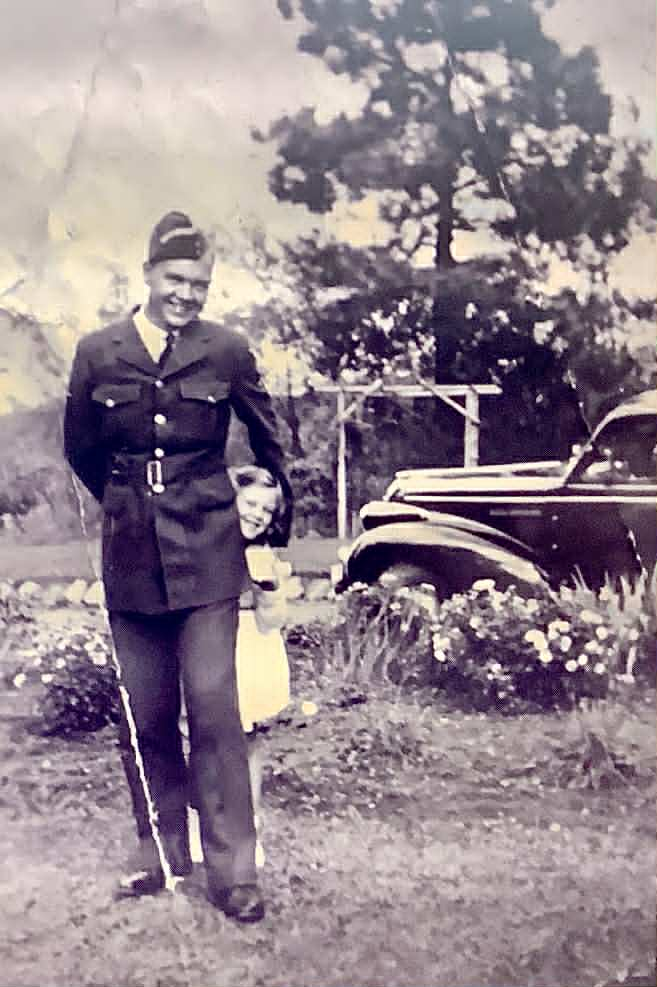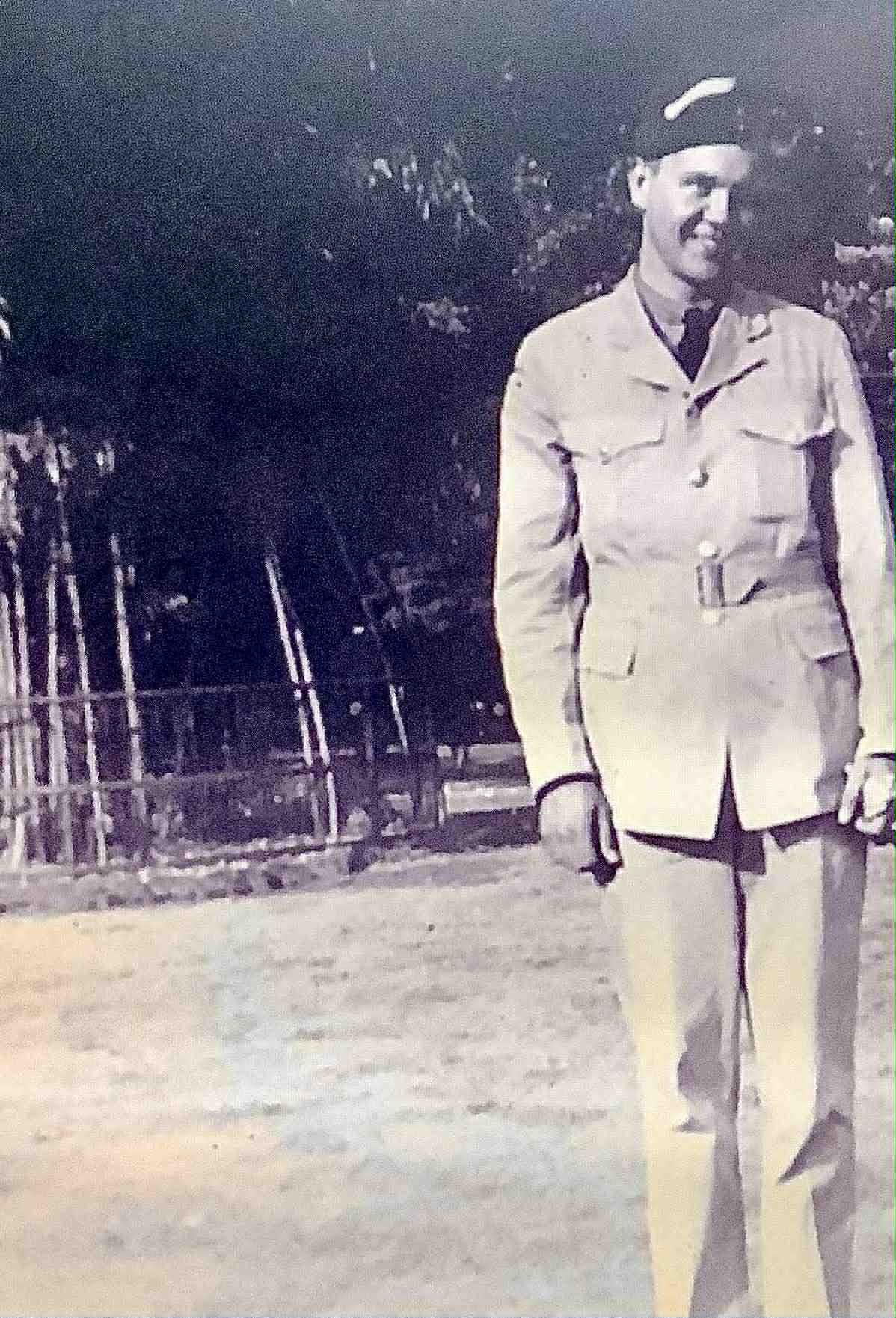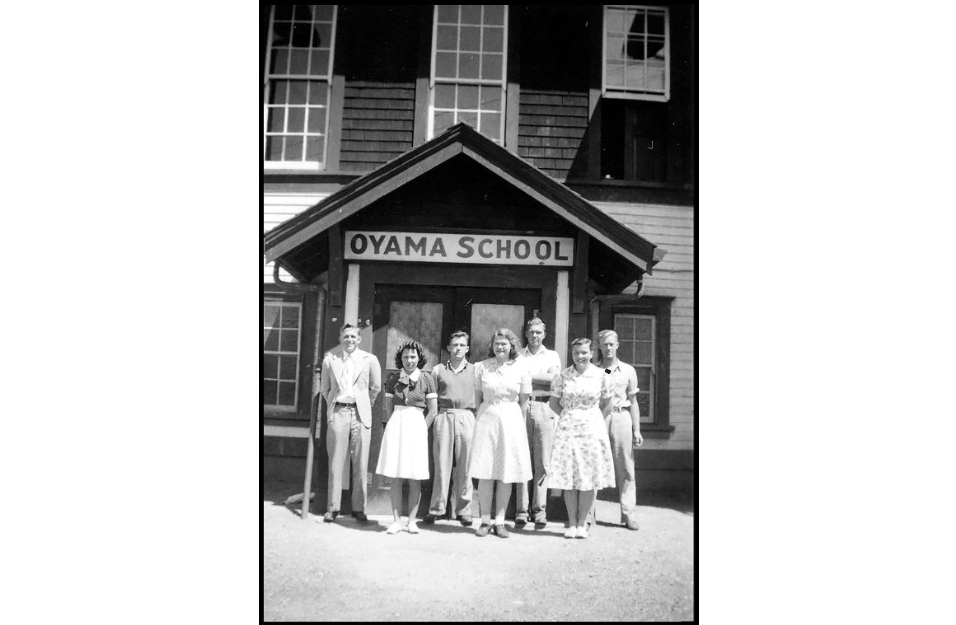John William Stephen, from Oyama, served as a pilot in the Royal Canadian Air Force (RCAF) during World War II. His service is commemorated on the Malta Memorial, a striking 15-meter-high Travertine marble column topped with a resplendent golden eagle, located just outside Valletta, the capital of Malta.
From an Oyama fruit farm to the skies above the Mediterranean, John’s path as a pilot was remarkable. Let’s explore how his journey in service unfolded.
John W. Stephen was born on April 8, 1921, at Jubilee Hospital in Vernon, BC, to loving parents John F. and Dorothy E. Stephen, of Oyama, BC. He was the eldest of John and Dorothy’s four children.
John’s formative years were spent at Oyama Public School (1928 – 1935) and Oyama High School (1936 – 1940), where he excelled in sports including hockey, tennis, football, basketball, and swimming. During his holidays, he worked as an apple box maker at the Vernon Fruit Union.
Soon after graduation, John enlisted at the RCAF Recruiting Centre in Vancouver, BC, with the aspiration to become a pilot. On March 11, 1941, he was accepted into the RCAF Special Reserve.

Photo: John Stephen with sister Valerie. Courtesy of Stephen Family.
The recruiting officer noted John’s enthusiasm to become a pilot but suggested his talents might be better suited for observer duties. Air observers played a crucial role in navigation and weapons deployment. The officer wrote:
“Comes from a good family of fruit ranchers. Is well informed generally and well above the average in intelligence and ability. Has shown aptitude in Maths, Physics, and Science, which subjects he likes and regularly obtained high marks in.
Is very keen on the Air Force and to be a pilot, but with his educational abilities, it would seem as though he is marked out for observer duties. When this was explained, he enthusiastically adopted the suggestion.
Is a pleasing, fine type of young man, in every way capable and to be relied upon.”
Undeterred by this suggestion, John moved forward with flight training. He embarked on a rigorous regimen of training that included two months at bombing and gunnery school in MacDonald, Manitoba, followed by a comprehensive 6 to 7-month program for both pilot and observer candidates. His elementary training took him across Canada, from Edmonton to Vancouver and Calgary, before he received an overseas posting to England for advanced training on January 21, 1942.
John completed his advanced flight training at RAF Grantham in April 1942 after which he was assigned to the No. 60 Operational Training Unit at RAF East Fortune, located just east of Edinburgh, Scotland.
He was trained on several iconic World War II aircraft in Canada and the United Kingdom, including the de Havilland Tiger Moth, Avro Anson, Bristol Blenheim, Bristol Beaufighter II, and the Airspeed Oxford Mk 1.

After several months in the United Kingdom, John was deployed to Malta in the Mediterranean. At that time, the Imperial War Museums commented:
“The British colony of Malta faced relentless aerial attacks by the Luftwaffe and Italian Air Force between 1940 and 1942. Malta was essential to the Allied war effort as it provided a base to disrupt Axis supply lines to Libya and for supplying British armies in Egypt.”
Canadians, like John, played a significant role in Malta’s defence, with up to 25% of the pilots in Malta’s RAF squadrons coming from Canada.
To reach Malta, John travelled via the Takoradi Route. This arduous route took him from Takoradi, Gold Coast (now Ghana), in West Africa, through the heart of the continent, over dense equatorial forest and barren desert plains. He reached Cairo, Egypt, on September 28, 1942. Along the way, he fell ill with a fever and sore throat and was treated for a suspected case of malaria.
Upon arrival, John was assigned to 267 Squadron in Bilbeis, Egypt, for a month, before joining the 272 Squadron, No. 201 (Naval Co-operation) Group, in Malta, on November 16, 1942. He skillfully piloted Beaufighters out of RAF Ta Kali (Ta’ Qali) Airfield, providing crucial air cover for naval convoys, a role that was both vital and perilous.
Tragically, on February 14, 1943, John died during a mission when his aircraft suffered an engine failure and ditched into the sea. While one crew member was rescued, John was not found and was reported missing, later presumed dead.
John’s death was deeply felt by his family, including his parents John and Dorothy, siblings Maurice, Dorothy, and Valerie, and fiancée Sadie Draper.
Warrant Officer Class II (Pilot) John W. Stephen’s sacrifice is commemorated on the Malta Memorial alongside those of 2,293 Commonwealth aircrew who lost their lives in various Second World War air battles and engagements throughout the Mediterranean, and who bear no known grave.

Oyama School, Grade 12 Class, 1940. (L to R) Teacher – Mr. G. Hall, Wilma Clement, Hume Powley, Mary MacLaren, John Stephen (at back), Margaret Getty, Jim Taylor. Image Courtesy: Museum and Archives of Vernon –No. 4578.
Researched by D. Scott Forfar
Sources:
Stephen, John William. Second World War Service Files – War Dead, 1939 to 1947. Library and Archives, Canada.
Warrant Officer Class II John William Stephen. The Canadian Virtual War Memorial (CVWM), courtesy Commonwealth War Graves Commission.
